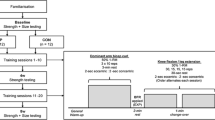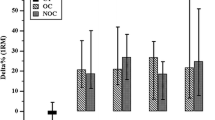Abstract
Background
The purpose of the present study was to investigate the effect of isokinetic training under the condition of restricted blood flow with pressure.
Methods
The subjects were 21 athletes at a university. They were classified into four training groups: group A (high speed under restricted blood flow condition with pressure); group B (low speed under restricted blood flow condition with pressure); group C (high speed without restricted blood flow condition); group D (low speed without restricted blood flow condition). The training session consisted of three sets of knee extension and flexion (repeated 10 times) using an isokinetic training machine (Biodex system 3). The training period was 4 weeks, with regular training sessions twice a week during this period. Before and after the training period, all of the subjects underwent measurements of quadriceps muscular strength of concentric contraction (CC) and eccentric contraction (EC) after isokinetic contraction as well as measurement of the thigh diameter. In addition, the group with restricted blood flow with pressure underwent magnetic resonance imaging (MRI).
Results
In regard to quadriceps muscular strength before and after training, there was a significant difference between groups A and C at many degrees of velocity. For the muscular volume measurements by MRI before and after training, no significant difference was seen in group A or group B. A significant increase was not seen even when comparing groups A and B.
Conclusions
Isokinetic resistance training with restricted blood flow with pressure had an effect on muscular strength improvement.
Similar content being viewed by others
References
Yoshigi H, Sawaki K, Nakamura A. The relationship between running performance and the leg strength of long distance runners. Res Q Athletics 2000;41:13–18 (in Japanese).
American College of Sports Medicine Position Stand. The recommended quantity and quality of exercise for developing and maintaining cardiorespiratory and fitness in healthy adults. Med Sci Sports Exerc 1990;22:265–274.
Baechle TR, Earle RW. Essentials of strength training and conditioning: National Conditioning Association. 2nd edn. Champaign, IL: Human Kinetics; 2000. p. 16–23.
Nakamura N, Nemoto I, Koyama Y, Kuroda Y. The study of safety of resistance training by continuous measurement of blood pressure in middle aged-men. Descente Sports Sci 1998;19:104–15 (in Japanese).
Takarada Y, Ishii N. Resistance training under restricted blood flow condition. J Health Phys Educ Recreat 1998;48:36–42 (in Japanese).
Takarada Y, Nakamura Y, Aruga S, Onda T, Miyazaki S, Ishii N. Rapid increase in plasma growth hormone after low-intensity resistance exercise with vascular occlusion. J Appl Physiol 2000;88:61–65.
Takarada Y, Takazawa H, Sato Y, Takebayashi S, Tanaka Y, Ishii N. Effect of resistance exercise combined with moderate vascular occlusion on muscular function in humans. J Appl Physiol 2000;88:2097–2106.
Abe T, Keams CF, Sato Y. Muscle size and strength are increased following walk training with restricted venous blood flow from the leg muscle, Kaatsu-walk training. J Appl Physiol 2006;100:1460–1466.
Clark BC, Fernhall B, Ploutz-Snyder LL. Adaptations in human neuromuscular function following prolonged unweighting. 1. Skeletal muscle contractile properties and applied ischemia efficacy. J Appl Physiol 2006;101:256–263.
Kawada S, Ishii N. Skeletal muscle hypertrophy after chronic restriction of venous blood flow in rats. Med Sci Sports Exerc 2005;37:1144–1150.
Hislop HJ, Perrine JJ. The isokinetic concept of exercise. Phys Ther 1967;47:114–117.
Kanehisa H. Muscle power and training. J Sports Sci 1983;2:23–24 (in Japanese).
Moffroid M, Whipple R, Hofkosh J. A study of isokinetic exercise. Phys Ther 1969;49:735–746.
Thistle HG, Hislop HJ, Moffroid M, Lowman EW. Isokinetic contraction: a new concept of resistive exercise. Arch Phys Med Rehabil 1967;48:279–281.
Kraemer WJ, Noble BJ, Clark MJ, Culver BW. Physiologic responses to heavy-resistance exercise with very short rest periods, Int J Sports Med 1987;8:247–252.
Fujino H, Sada S, Sada M. Effect of resistance training with partial vascular occlusion after anterior cruciate ligament reconstruction. J Clin Sports Med 2000;8:247–251 (in Japanese).
Ota H, Kurosawa H, Sakuraba K, Ikeda H, Iwase T, Sato N, et al. Effectiveness of low-load resistance muscular training under moderate restriction of blood flow for atrophic muscles-study of training after anterior cruciate ligament reconstruction. J Clin Sports Med 2002;10:282–289 (in Japanese).
Author information
Authors and Affiliations
About this article
Cite this article
Sakuraba, K., Ishikawa, T. Effect of isokinetic resistance training under a condition of restricted blood flow with pressure. J Orthop Sci 14, 631–639 (2009). https://doi.org/10.1007/s00776-009-1374-3
Received:
Accepted:
Published:
Issue Date:
DOI: https://doi.org/10.1007/s00776-009-1374-3




